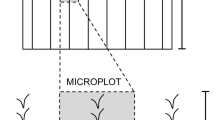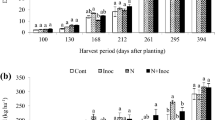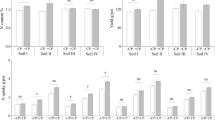Summary
The symbiotic association of the water fernAzolla with the blue-green algaAnabaena azollae can fix 30–60 kg N ha−1 per rice cropping season. The value of this fixed N for rice production, however, is only realized once the N is released from theAzolla biomass and taken up by the rice plants. The availability of N applied asAzolla or as urea was measured in field experiments by two15N methods. In the first,Azolla caroliniana (Willd.) was labelled with15N in nutrient solution and incorporated into the soil at a rate of 144 kg N ha−1. The recovery ofAzolla-N in the above ground parts of rice [Oryza sativa (L) cv. Nucleoryza] was found to be 32% vs. 26% for urea applied at a rate of 100 kg N/ha; there was no significant difference in recovery. In the second, 100 kg N/ha of15N-urea was applied separately or in combination with either 250 or 330 kg N ha−1 of unlabelledAzolla. At the higher rate, the recovery ofAzolla-N was significantly greater than that of urea. There was a significant interaction when both N sources were applied together, which resulted in a greater recovery of N from each source in comparison to that source applied separately. Increasing the combined urea andAzolla application rate from 350 kg N ha−1 to 430 kg N ha−1 increased the N yield but had no effect on the dry matter yield of rice plants. The additional N taken up at the higher level of N application accumulated to a greater extent in the straw compared to the panicles. Since no assumptions need to be made about the contribution of soil N in the method using15N-labelledAzolla, this method is preferable to the15N dilution technique for assessing the availability ofAzolla-N to rice. Pot trials usingAzolla stored at −20°C or following oven-drying showed that both treatments decreased the recovery of N by one third in comparison to freshAzolla.
Similar content being viewed by others

References
AOAC 1980 Official methods of analysis, 13th ed., AOAC, Arlington, Va. Secs. 7.025–7.031.
Becking J H 1976 Contribution of plant-algal associations.In Proceedings of the First International Symposium on Nitrogen Fixation. Vol. 2 pp 556–580, Eds W E Newton and C J Nyman, Washington State Univ. Press, Pullman, U.S.
Fiedler R and Proksch G 1975 The determination of nitrogen-15 by emission and mass spectrometry in biochemical analysis: A review. Anal. Chim. Acta 78, 1–62.
Fried M and Middelboe V 1977 Measurement of amount of nitrogen fixed by a legume crop. Plant and Soil 47, 713–715.
International Rice Research Institute 1983 Revised report on the fourth trial on Azolla use in rice, INSFER (1982) Los Baños, Laguna, Philippines.
Kulasooriya S A and De Silva R S Y 1977 Effect of Azolla on yield of rice. IRRI Newsletter. 2, 10.
Liu C C 1979 Use of Azolla in rice production in China.In Nitrogen and Rice. pp 375–394, Int. Rice Res. Inst., Los Banos, Philippines.
Moore A W 1969 Azolla: biology and agronomic significance. Bot. Rev. 35, 17–34.
Peters G A 1977 TheAzolla-Anabaena azollae symbiosis.In Genetic Engineering for Nitrogen Fixation. pp 231–258 Ed. A Hollaender, Plenum Press, New York.
Singh P K 1977 Effect of Azolla on the yield of paddy with and without application of N fertilizer. Curr. Sci. 46, 642–644.
Steel R G and Torrey J H 1960 Principles and Procedures for Statistics. McGraw Hill Book Company, New York.
Talley S N and Rains D W 1980Azolla filiculoides Lam. as a fallow-season green manure for rice in a temperate climate. Agron. J. 72, 11–18.
Tran Q T and Dao T T 1973 Azolla a green compost. Vietnamese studies. Agric. Problem 38, 119–127.
Watanabe I, Espinas C R, Berja N S and Alimagno B V 1977 Utilization of theAzolla-Anabaena complex as a nitrogen fertilizer for rice. IRRI Res. Paper Series No. 11.
Watanabe I, Bai Ke-Zhi, Berja N S, Espinas C R, Ito O, and Subudhi B P R 1981 TheAzolla-Anabaena complex and its use in rice culture. IRRI Res. Paper Series No. 69.
Watanabe I 1982Azolla-Anabaena symbiosis-its physiology and use in tropical agriculture.In Microbiology of Tropical Soils and Plant Productivity. pp 169–185, Ed. Y R Dommergues and H G Diem. Martinus Nijhoff, The Netherlands.
Author information
Authors and Affiliations
Rights and permissions
About this article
Cite this article
Kumarasinghe, K.S., Zapata, F., Kovacs, G. et al. Evaluation of the availability ofAzolla-N and urea-N to rice using15N. Plant Soil 90, 293–299 (1986). https://doi.org/10.1007/BF02277404
Issue Date:
DOI: https://doi.org/10.1007/BF02277404



